Here is a list of all the quarters of Florence: this administrative division is not very interesting for the tourists: for those who are staying in Florence for a short time, the part “Classic Tours of Florence” is very useful to have an organic image of the town, but if you are curious, are staying more and if you prefer to have a one day tour in a quarter of Florence as if you were in a village where you can walk around and visit all, here are some advices.
| The quarters of Florence in alphabetical order are: | |
|
|
The following tours I suggest are intended for exhaustive touring of the Florence quarters:
- Tour 1 Quarter Duomo and Signoria Square
- Tour 2 Quarter the area around Repubblica Square
- Tour 3 Quarter Santa Maria Novella
- Tour 4 Quarter San Giovanni
- Tour 5 Quarter Santa Croce
- Tour 6 Quarter Oltrarno
- Tour 7 Quarter Piazzale Michelangelo
Tour 1 Quarter: Duomo and Signoria Square
The first part of the tour includes the Duomo and Piazza della Signoria which are the religious and the civic centre of the town, its heart where all the masterpieces and monuments which made Florence so famous where thought out and made.
Start this tour from Duomo Square, the religious centre of Florence, where the Duomo, the Baptistery, the Bishop palace, Giotto bell tower are located. This part of Florence was inside the ancient walls. The first Cathedral of the town was outside the city walls and it was San Lorenzo Church, this was built in the 4th century; in the VII century the title of “Cathedral” passed to Santa Reparata which in 1296 was rebuilt as Santa Maria del Fiore: the Cathedral we see to day (see description in the section “Churches”). In this period the religious centre was separated from the civic centre with the building of the new civic palace. Palazzo Vecchio (Palazzo della Signoria).
Duomo Square and San Giovanni Square the first with the Cathedral and Giotto Bell tower, and the second with San Giovanni Baptistery, make up the most important religious complex of Florence. Before visiting the single monuments have a walk around the two squares and see the other buildings. On the corner with Via Calzaioli you can see the “loggia del Bigallo” a marble elegant loggia by Ambrogio di Rienzo (1353 – 1358) with large decorated arches and parts of frescoes.
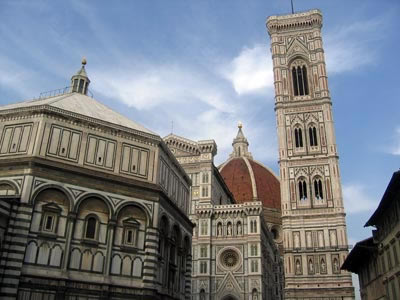 In S. Giovanni Square (behind the Baptistery) is the Bishop Palace by Giovanni Dosio (1573 – 1584). Do not forget to have a look on the back side of the palace in “Piazza dell’Olio” where you can see one of the oldest façades of Florence: the little church of San Salvatore al Vescovo. This façade helps us to understand the Baptistery external covering and the façade of San Miniato. Remember the two of them when you visit the third one so that you can have an organic idea of the Florentine Romanic. Between Via Ricasoli and Via de’ Servi, you can see old houses with stone arches which date back to 15th century: the Strozzi Niccolini Palace where Donatello had his studio (half length portrait). Now we are near the entrance of the Museo dell’Opera del Duomo. Visit it if you have time, but not now. Before visit the Cathedral and the Baptistery because in this museum you’ll see the original works which were in these two buildings. Into the Duomo (Cathedral) you can have a free tour in English by one of the volunteers.
In S. Giovanni Square (behind the Baptistery) is the Bishop Palace by Giovanni Dosio (1573 – 1584). Do not forget to have a look on the back side of the palace in “Piazza dell’Olio” where you can see one of the oldest façades of Florence: the little church of San Salvatore al Vescovo. This façade helps us to understand the Baptistery external covering and the façade of San Miniato. Remember the two of them when you visit the third one so that you can have an organic idea of the Florentine Romanic. Between Via Ricasoli and Via de’ Servi, you can see old houses with stone arches which date back to 15th century: the Strozzi Niccolini Palace where Donatello had his studio (half length portrait). Now we are near the entrance of the Museo dell’Opera del Duomo. Visit it if you have time, but not now. Before visit the Cathedral and the Baptistery because in this museum you’ll see the original works which were in these two buildings. Into the Duomo (Cathedral) you can have a free tour in English by one of the volunteers.
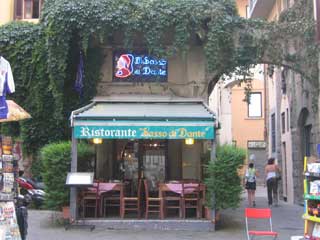 Proceeding around the square near nr 54 (red) you can find a memorial tablet which indicates where Dante’s stone was: a stone where Dante was thought to seat in summer evening to refresh himself. There is a story about this habit of the most important Florentine and Italian poet: once, while he was sitting on the stone, a friend of his asked the poet: “what is the best food for you?” Dante answered: “the boiled egg”. One year later the friend passed again in front of the sitting poet and asked:”How?”, “with some salt!” answered the poet.
Proceeding around the square near nr 54 (red) you can find a memorial tablet which indicates where Dante’s stone was: a stone where Dante was thought to seat in summer evening to refresh himself. There is a story about this habit of the most important Florentine and Italian poet: once, while he was sitting on the stone, a friend of his asked the poet: “what is the best food for you?” Dante answered: “the boiled egg”. One year later the friend passed again in front of the sitting poet and asked:”How?”, “with some salt!” answered the poet.
In this little square named “Piazza delle Pallottole” you find a nice good restaurant: “Sasso di Dante”.
Going on around the square you’ll find two big statues: Arnolfo (di Cambio) and Brunelleschi. Arnolfo di Cambio was the architect who in 1296 built the cathedral and Brunelleschi was the one who built the dome. A little further on there is the seat of the Arciconfraternita della Misericordia, founded by S. Pietro Martire in 1244 to give assistance to the invalid and sick people and to bury the poor dead people (this institution was the precursor of the modern ambulance rescues and it is still working very well). Have a look inside.Now you can start your visit of the Baptistery: first outside and then inside (see churches section for the description) and later of the Cathedral. In the square there are many bars and restaurant, to rest and have a good coffee or cappuccino.
If you like you can also climb on the dome or on Giotto bell tower. I prefere the dome (463 steps) because it is a little higher thank the bell tower (414 easy steps); the panorama is almost the same but you can visit the dome both outside and inside so that you can admire the frescoes by Vasari and Zuccari very close (see “churches” section).
Now it is time for you to visit the museum (Museo dell’Opera del Duomo) but first have a look in Via dello Studio a little street from Duomo Square. Here in a little building at the corner with Via della Canonica is the seat of the Opera del Duomo. This foundation was born together with the cathedral and, since 1296, it follows the works of everything concerning the church: projects, building, restoring and so on. You are not allowed to enter, but you can have a look from the glass door, for sure somebody is working to restore pieces of the Cathedral.
The logo of this foundation is OPA, the contraction of the Latin word OPERA: the symbol P has a double value as R an P. In many place inside the Cathedral and outside you can see this logo. The description of the Museum is in “museums” section.
Piazza della Signoria – Uffizi
The civic centre of Florence dates back to the second half of the 13th century. What we see today is only one part of the square which changed several times during the centuries. As in many Tuscan cities the public palaces were several not only one. In a few years they built the Bargello palace (the palace of the People’s Captain) and the Priori palace, which is Palazzo della Signoria also named Palazzo Vecchio, which was planned to give the town a symmetric civic centre with the religious one.
In 1540 Cosimo the 1st Medici moved his residence from Medici Palace in Via Cavour (once Via Larga) to the Signoria Palace, which, when the Medici Family moved again to Pitti palace (1565), was called Palazzo Vecchio (The old palace)
If you start the visit coming from Duomo Square, you can walk along Via Calzaioli, this street was enlarged in 1841/44 in the part which goes from the Duomo to Via Condotta. It has always been a commercial street, but once is was full of shoes shops (Calzaioli = shoe makers), now it has plenty of pizzerie (on my opinion expensive and not very good) and the old fascinating shops are gone.
The most important monuments in this street are: San Carlo de’ Lombardi on your left (by Neri di Fioravante and Benci di Lione) – 1349). In front of it the impressive building of Orsanmichele one of the most interesting buildings of the 14th century in Florence.
In 1290 Arnolfo di Cambio (the same architect of Duomo and Palazzo Vecchio), built a loggia for the wheat market, in 1304 a fire destroyed the loggi, it was rebuilt in 1337 (Francesco Talenti and Neri di Fioravante).
A few steps and you are in Piazza della Signoria. In front of you the Old Palace.
In the square we start our tour from the equestrian monument of Cosimo the 1st Medici made in bronze by Giambologna (1594/98)
Also in bronze the bas relieves of the base representing parts of Florentine history.
Near the corner of Palazzo Vecchio the Neptune fountain by Bartolomeo Ammannati (1563-65).
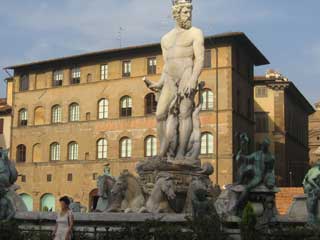 This fountain was built to celebrate the building of a new waterworks . The big imagine of Neptune – the God of the oceans – is not very interesting; much more beautiful are the bronze statues around the fountain.
This fountain was built to celebrate the building of a new waterworks . The big imagine of Neptune – the God of the oceans – is not very interesting; much more beautiful are the bronze statues around the fountain.
 On the left hand on the steps of the palace you can see the “Marzocco”
On the left hand on the steps of the palace you can see the “Marzocco”
one of the heraldic symbols of Florence: a lion with the Florentine lily. Some living lions were kept in a zoo behind the palace along Via de’ Leoni (Lions’ street). The name of Marzocco comes from of Mars, the Latin God of the war, whom, in the Roman period, the town was dedicated to. On the right of the Marzocco a copy of the sculpture “Judith and Olofern” by Donatello (The original is inside the palace in the “Sala dei Gigli”.
Also the statue of the David by Michelangelo is a copy, the original is in Accademia Museum (Do not miss it!). This statue was placed here to celebrate the victory of the democracy over the tyranny.
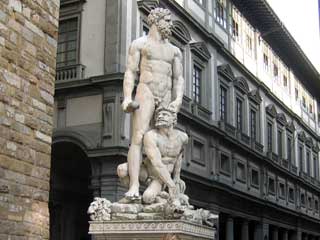
One more sculpture on the right of the palace entrance: “Hercules and Caco “ by Baccio Bandinelli is to celebrate the Medici Family victory over their interior enemies.
On the right there is the elegant and rich “Loggia della Signoria” also named Loggia dell’Orcagna from the nickname of Andrea di Cione who built it (1376/82). This building is also called “Loggia dei Lanzi” Fron the name of the mercenary soldiers who camped here: the lansquenet – lanzichenecchi -.
Cosimo the 1st turned this loggia in a sculpture studio. On the top there are arches and tiles in blue background representing the Cardinal and Theological Virtues.
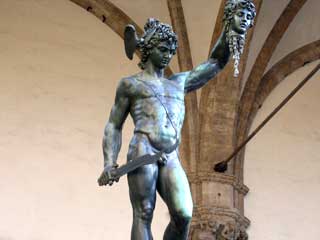
Under the left arch there is the famous bronze masterpiece by Cellini the “Perseus” (1554) who is showing the Medusa’s cut head.
This sculpture was placed here to front the two masterpieces: The David by Michelangelo and Judith and Olofern by Donatello.
Also of great interest is the marble group “The rape of Sabine women” by Giambologna who gives, with this work, a good specimen of the human body movements. We can have a complete and organic view of the statue from several parts around it.
Now you can start the visit of the Old Palace. If you are not visiting it inside, you can at least have a look around in the first yard to admire the Verrocchio’s putto ( angel).
Aside the Old Palace you find the Uffizi Gallery (see “Museums” section), over it and across the River Arno (by the Old Bridge) the Vasarian Corridor which arrives to Pitti Palace (See “tour along the river”)
Before or after the visit to the palace you can have a nice rest at Revoire’s one of the oldest bars of Florence famous for its chocolate.
Now let’s go on with our tour: on the corner of Via de’ Gondi the palace of the “tribunale di Marcatanzia” where a judge settled the quarrels among the Florentine merchants. Then the Condotta Palace and via de’ Magazzini. The name of Condotta (street an palace) comes from the officers who in this part of Florence, used to pay the soldiers “to conduct” war.
Via de’ Magazzini enlarges in Piazza San Martino with an oratory and a little church (1441). On the corner there is a tabernacle with the image of St Martino giving alms to poors, painted by Cosimo Ulivelli.
Inside the church the ten lunettes with frescoes of St. Martin’s stories, are very interesting as document of the costume of the time.
On the opposite side of the square there is the ancient façade of the Florentine Badia with the portrait of Ugo di Toscana. On the corner the Torre della Castagna (Chestnut Tower) where the Priors used to meet before the Old Palace was built (1282).
The name comes from the use to put a chestnut into a ballot box to vote a decision. Proceed on the right to meet Dante’s house, this is not the real house of the poet, but a rebuildind of 1921. In the house you can visit a museum. On the left you pass by the little church of Santa Margherita dei Cerchi, the church of Beatrice, Dante’s love (1353). At the end of this little street you are in Via del Corso, the Banca Toscana is now in an beautiful palace: Palazzo Portinari Salviati: once a year you can visit it free on Sunday morning (usually in March or April). One more church here: Santa Maria de’ Ricci (1505) have a look inside and if you like music and concerts read the program of the week, in the evening you can go to hear a concert. Before arriving in Via Calzaioli, turn right in a little street (in front of Coin store corner) after a few steps you are in a nice little square. Here in front of you there is the Pagliazza tower which now is part of Brunelleschi Hotel, but once this building was a jail for women, the name ”Pagliazza” means “palliasse” which was the poor mattress where the prisoner women slept.
Walk around these little streets full of history, of house-towers, of tabernacles and of shops. One of the oldest shops of Florence is “Pegna” now it has been restored as a little supermarket, but they made a good renovation and the shop is still fascinating, has good things and good foods, sometimes a little more expensive than in bigger supermarkets but if you are staying in this part of Florence, this is very easy for you.
Back to tours list
Tour 2 Quarter: the area around Repubblica Square
As you can see this part is strictly connected to the first part and follows the same direction, I separated these parts because you can feel the solemnity of the fist tour and then appreciate the other monuments, streets churches which will enrich your first imagine of the town. This is like when you show your house to an important visitor: first you introduce him in the drawing room, only later you show him the rest of the house and only later your visitor can have a complete idea of your home.
We start this tour from Duomo Square through Via Calzaioli to Orsanmichele.
We already visited this important church in the previous tour (Piazza della Signoria area). In front of Orsanmichele entrance there is the Palazzo dell’Arte della Lana which had been seat of this guild since 1308.
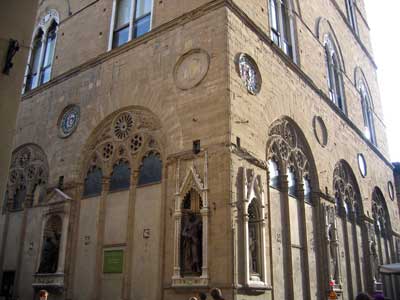
On the corner the big tabernacle “Santa Maria della Tromba” a rebuilding of the original tabernacle of 14th century. Go on in this direction in Via Lamberti, cross Via Calimala and arrive in front of the post office palace. On the left you arrive in a nice little square with the palace of Capitani di Parte Guelfa.
If it is open you can visit this palace (free entrance: two large halls where you can see the costumes and accessories for the “Calcio Storico Fiorentino” (Florentine kick game). This was an early form of football that was played between teams of different quarters of Florence in squares as Santa Maria Novella or Santa Croce. Even now a day in spring and summer you can watch a match in Santa Croce. Coming out of the palace on your right you find the New Market Loggia (1547/51) where, on one side, there is a tourist market, in front of the palace of “Borsa Merci” this is a new palace because the original one was destroyed in the last world war. This part of Florence was hardly bombed during the second world war by theGerman soldiers, whose commander decided to save the Old Bridge and the most important places such as Palazzo Vecchio.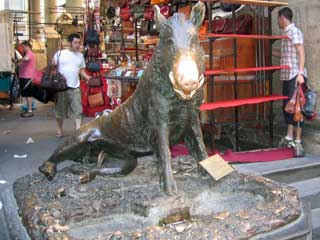
In front of this modern palace you can stop and touch the “porcellino” as Florentine people call a bronze copy of the marble statue of a wild boar by Pietro Tacca (1612) The original is in Uffizi Gallery. If you touch the snout you’ll have good luck and if you throw a coin into his mouth and it fells down into a grate you’ll come again to Florence! (you can try several times).
Go on walking along Via Portarossa and arrive at Palazzo Davanzati (nr 13) the private palace perfectly preserved with its stone fa çade. This palace is so well preserved that became the museum of the old Florentine private house.You can visit it.
Before arriving in Piazza Santa Trìnita, you see the Bartolini Palace, now hotel Portarossa with the Monaldi tower.
As soon as you enter the irregular square, you are in front of the Justice column, a big monolith which comes from the Caracalla Thermal Baths in Rome and which was given by the Pope to Cosimo the 1st Medici. The square is rich in splendid palaces: Palazzo Bartolini Salimbeni by Baccio d’Agnolo (1520/23).
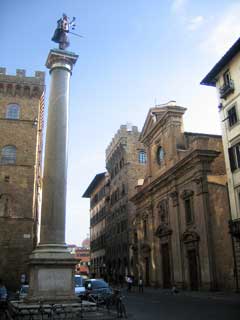 Palazzo Buondelmonti an Palazzo Spini-Ferroni. In front of you there is the Santa Trìnita basilica, built in the second half of 11th century. The church was enlarged in 1300. The façade was made in 1593/94 by Bernardo Buontalenti.
Palazzo Buondelmonti an Palazzo Spini-Ferroni. In front of you there is the Santa Trìnita basilica, built in the second half of 11th century. The church was enlarged in 1300. The façade was made in 1593/94 by Bernardo Buontalenti.
Now go on in the street between Palazzo Buondelmonti and Palazzo Spini Ferroni, this street is Borgo SS. Apostoli. After a few meters the street enlarges in a nice little square with a ancient charming little church: Ss Apostoli (11th century) (description in “Churches” part) A side of the church The Altoviti Palace (1512)
Proceeding in Borgo Ss. Apostoli, you can see the Rosselli del Turco Palace by Baccio d’Agnolo (1507). This area was hardly bombed in the last world war and many buildings were rebuilt after the war keeping the original volumes. Two ancient towers were not destroyed: the Baldovinetti tower (nr 4) and the Amidei Tower (nr 9 red) called “Bigonciola” and decorated with two lion heads of the Etruscantime. Now you are in Via Por Santa Maria, in front of you another little square with a nice church (usually closed): Santo Stefano in Ponte.
Walk along via Por Santa Maria as far as Piazza della Repubblica, this square was rebuilt in 18 th century enlarging the ancient old market square which had been built over the Forum of the old Roman city.
Many famous bars are in this square: Le Giubbe Rosse or Gilli are the most famous. If you like you can have a stop here, sometimes there are little concerts.
To the other side of the arch Via degli Strozzi starts: at nr 4 the Vecchietti Palace planed by Giambologna in 1578 but built much later. On the corner the copy of a bronze sculpture by Giambologna “The little devil” (the original one is in Palazzo Vecchio).
Go on and arrive in Strozzi Square where you can admire the grand Strozzi palace 1489 – At nr 2 there is the Strozzino Palace which is a cinema now. Walking along the Strozzi Palace you arrive in Via Tornabuoni one of the most elegant streets in Florence with famous palaces and the best shops. Going to the Duomo on the right near the corner with Via Strozzi, you can find one of the oldest and most famous (for Florentine people, not for tourists) groceries of Florence: Procacci.
Have a stop here, the shop is very little and there are only two or three little tables, here you can taste the best rolls with truffle in Florence and a good glass of wine in an intimate and suggestive place.
At the end of Via Tornabuoni you can find Piazza Antinori with the Palace (Palazzo Antinori) built in1461/69 by Giuliano da Maiano. May be the name of this palace is familiar to you, because the Antinori Family produces many of the best Chianti wines! In front of the palace the church of San Gaetano (description in “Churches” section).
Before arriving in Duomo Square you can also visit Santa Maria Maggiore a medieval church and in front of it there is the palace of the hundred windows which, just for a change, now belongs to a bank.
Back to tours list
Tour 3 Quarter: Santa Maria Novella
At a first glance you may think this is a very little tour, but in actual fact it is a very important tour, one of the most rewarding and rich you can have in Florence. By the way, before starting this tour, read in the general part what I wrote about Santa Maria Novella and Santa Croce, it is useful to understand these two important churches.
You can start this tour from Santa Maria Novella, the main railway station in Florence built in 1933/35 by Michelucci Group. Take via degli Avelli, in front of the train station and arrive in Piazza Santa Maria Novella, the church is one of the most famous and beautiful churches in Florence, rich of masterpieces. Admire the square and the façade by Leon Battista Alberti. You need the whole morning to visit the church and the Cappellone degli Spagnoli, the green cloister (Description in “Churches” section) – You can have a free tour of the church. Coming out from the church, go to the left in via delle Belle Donne there is a little square with a column: The Croce al Trebbio (1338) with the symbols of the Evangelists.
If you go to your left, you arrive near Via Tornabuoni, if you take via Rucellai, on the right, you arrive in Piazza Rucellai, also this square was planned by Leon Battista Alberti. The important Rucellai palace was built in 1455/70. On the ground floor now there is the Museum of the History of photography Alinari Bros. The loggia dates back to 1463/66. Walk along the palace and arrive in Piazza San Pancrazio, there is one more building of Rucellai family by Alberti: the Rucellai Chapel (the entrance is in via della Spada) Inside you can visit the beautiful little temple of the Holy Sepulchre, made by Leon Battista Alberti (1467).
In the ex Church of St. Pancrazio now you can visit the Museum of Marino Marini (1901/1980). 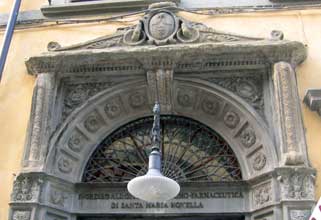
Walk along these streets and arrive in Via della Scala, at nr 16 you can find the famous old Pharmacy of Santa Maria Novella – don’t miss it! – This was the ancient pharmacy of the monastery.
Now walk along via della Scala and in Via Orti Oricellari (the name comes from Rucelai name), there is the palace of Venturi Ginori family. At the end of the street there is a triangular space named “Il Prato”. Here, on the right, you can see a very high old wooden door this is the “house” of the cart. The explosion of the cart is an ancient ceremony which takes part every Easter Sunday in front of the cathedral and which dates back to the first Crusade.
Back to tours list
Tour 4 Quarter: San Giovanni
As you can see, we are always going around in the city historical centre, walking but without covering a large distance (even if your legs do not agree), in fact there is a so big concentration of monuments and art works that you can stand for hours without going very far.
The three parts of this district may be visited in this order:
1) San Lorenzo
This neighbourghood grew up around the Basilica of San Lorenzo which was the first Fiorentine Cathedral, its first building dates back to 393. Of course Medici family gave prestigious monuments to this part of the town, first of all Medici Riccardi Palace. This is the typical Florentine noble family palace, built by Michelozzo in 1444 with a facade in classic Florentine style in the lower part a strong ashlars- work, over it squared stones and on the top a smooth coating. A
All the surface is marked by mullioned windows with two lights.
Visit this palace. Inside you can admire the little famous Magi Chapel by Benozzo Gozzoli – 1459 – the most famous frescos in the Florentine Renaissance.
Going out of the palace walking along via de’ Gori you arrive in San Lorenzo Square. First you find the monument to Giovanni dalla Bande Nere, father of Cosimo the first Medici, made by Baccio Bandinelli, then the church of San Lorenzo: the façade is unfinished in spite of the project by Michelangelo.
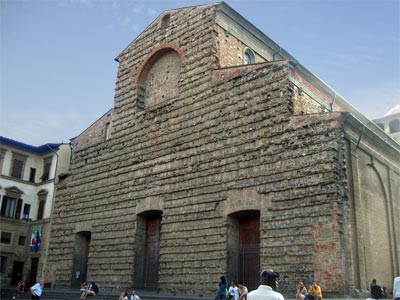 This was the first Cathedral of Florence (393), rebuilt in 1059. In 1419 the Medici decided to renew the church; the project was asked to Brunelleschi. (see description in “Churches” section).
This was the first Cathedral of Florence (393), rebuilt in 1059. In 1419 the Medici decided to renew the church; the project was asked to Brunelleschi. (see description in “Churches” section).
Visit the basilica, the old Sacristy, the cloister, the Laurenziana library by Michelangelo who made here one of the most interesting and charming building. In the apse, the Medici chapel by Michelangelo will complete your visit to San Lorenzo. Now walk around about the streets of the old market, visit the market inside and if you like, have a lunch with a “Panino col lampredotto” or a “panino con il lesso” (bread with beef interiors – stomach -) or (bread with boiled beef) and a good glass of Chianti. At the end of Via dell’Ariento, in via Faenza you can see the tabernacle named “Le Fonticine” a big tabernacle on a marble fountain. In Via Faenza you can visit (nr 40) the Fuligno convent with its famous Last Supper.
2) San Marco
If you are coming from the San Lorenzo tour, you surely have seen the Medici Riccardi Palace and the wonderful frescoes by Benozzo Gozzoli. This is a good connection with what you are going to see in this tour: Beato Angelico’s paintings in San Marco Museum, where you can admire some paintings made by the two artists who worked together. From Medici Riccardi Palace, arrive to the next crossing, the street is now called via Cavour. Here there are many important old palaces: Panciatici Palaca (nr.2) by Carlo Fontana, Covoni Palaca (nr. 4) by Buontalenti 1623, Ginori Conti Palace (nr 13) where for a little time Giacomo Rossini lived (there is a memorial tablet on the façade). Further (nr 18) there are Capponi Palace and Dardinelli Palace now seat of the Marucelliana Library, an important rich library dated back to 1752.
We are now in San Marco Square. In front of you there is the church of San Marco and the entrance to the museum. You cannot miss this museum, which is a part of the ancient monastery, it is not very big but in it you’ll find the masterpieces by Beato Angelico. Are you tired? In front of the church you can find a bakery: Pugi. It is always full of Florentine people, here you can taste the best “schiacciata con l’olio” (flat bread with olive oil) you can find in Florence but also pizza and focacce (filled flat bread). The shop is little so buy what you prefer and eat it outside on one of the benches in the little garden in the centre of the square.
Now you can go to Via La Pira where there are some university museums and the beautiful botanical Garden. From the square you can proceed along Via Cavour and visit the “Chiostro delle Scalzo” (nr 69 open only on Monday, Thursday and Saturday 8.10/13.50) where you can see the frescoes by Andrea del Sarto. On the south west corner of the Square in Via XXVII Aprile nr 1 the important Cenacolo di Santa Apollonia with the famous Last Supper by Andrea del Castagno.
3) SS. Annunziata
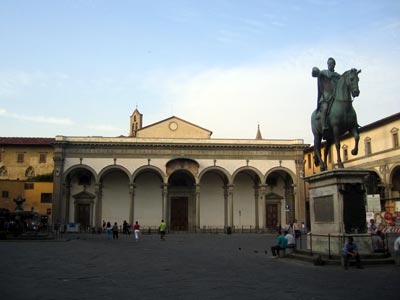 From San you are quickly in SS. Annunziata Square: in front of you the Ospedale degli innocenti an important foundation for the history of Florence and its culture because it is not only a magnificent building by Brunelleschi (1419), but it was planned in rational and functional way to recover, to nurse and to educate foundlings.
From San you are quickly in SS. Annunziata Square: in front of you the Ospedale degli innocenti an important foundation for the history of Florence and its culture because it is not only a magnificent building by Brunelleschi (1419), but it was planned in rational and functional way to recover, to nurse and to educate foundlings.
Under the loggia you can see the wheel where babies were placed and left in anonymous way. This arcade was planned by Brunelleschi in a very new, geometrical formulation: the span of the arches is the same as the columns and as the distance from the back so that the arcade seems to be built with a sequence of cubes. This harmonious long arcade is the conjunction between the empty space of the square and the full space of the buildings.
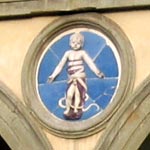 Very interesting are also the “tondi” (circles) with babies in swaddling clothes by Della Robbia.
Very interesting are also the “tondi” (circles) with babies in swaddling clothes by Della Robbia.
In front of this arcade there is another similar arcade (dei Serviti) by Antonio a Sangallo il Vecchio e Baccio d’Agnolo (1516). The two arcades are like theatre wings which introduce the church’s façade.
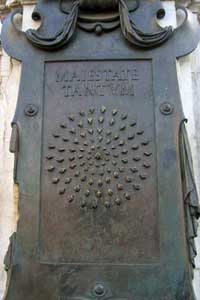 In the centre of the square there is the Statue of the Duke Ferdinando the 1st by Giambologna and finished by his pupil Pietro Tacca (try to count the flies in the back basement of the statue: it will be very hard, almost impossible!)
In the centre of the square there is the Statue of the Duke Ferdinando the 1st by Giambologna and finished by his pupil Pietro Tacca (try to count the flies in the back basement of the statue: it will be very hard, almost impossible!)
By Pietro Tacca are also the two beautiful twin fountains.
On the corner with Via della Colonna there is the entrance of the Archaeological Museum, a good quiet museum with an Egyptian section and a large part of Etruscan art with masterpieces as the “Chimera d’Arezzo” and the “Arringatore”. On Saturday morning you can have also a tour of the beautiful garden.
Proceed along Via della Colonna to Via della Pergola, turn right in this street. Here is the Pergola Theatre built in 1656 by Faerdinando Tacca. At the end of the street, turn right, you are in Via Sant’Egidio and after a few meters you are in Santa Maria Nuova Square, here is the most ancient hospital of Florence via della pergola, Sant’egidio (biblioteca e museo F.no di preistoria Santa Maria nuova, via Oriolo museo di Firenze com’era. via dei servi, San Michele Viasdomini rotonda Brunelleschi.
Back to tours list
Tour 5 Quarter: Santa Croce
Symmetrical to Santa Maria Novella, in the city centre of Florence, is the church of Santa Croce. Santa Maria Novella was a Dominican Monastery and Santa Croce was Franciscan. Both the churches were built outside the city walls. Santa Croce Square has been together with Signoria Square one of the most important places where the Florentines used to meet for special events and still now in this square they play the Calcio Storico, which is an early form of football.
You surely noted our tours always start from Duomo Square, this is because I think that this square is the centre of the centre of Florence..
From Duomo Square (back of the dome) take via del Proconsolo, on the left you soon find a little church: Santa Maria in Campo, then the anthropologic museum at number 12 the Nonfinito (unfinished) Palace, at nr 10 the Church of Badia Fiorentina, the building complex (monastery and church) dates back to 978 it is a Benedictine monastery which was founded by Willa, mother of the marquis Ugo di Toscana who is buried here and for whom every year in December, a few days before Christmas (the 21st), a Mass is celebrated for him in the presence of Authorities and with the Florentine Gonfalone.
The church was modified by Arnolfo di Cambio in 1285.
On the opposite part of via del Proconsolo the Captain Palace also called Bargello, this was the first palace in Florence which was built (1255/61) as seat of the city government. Now it is seat of the National Museum, one of the most important museums in Italy where sculptures and other masterpieces by Donatello, Della robbia, Michelangelo, Verrocchio are collected. The entrance is near the Volognana tower, its bell rings only the first day of every century or in case of war. The bell rang also the 4 of November 1966 (the big flood).
On the other side, in Piazza San Firenze, there is Gondi palace, one of the most representative private palaces in Florence, it was built in 15th century by Giuliano da San Gallo (1490) with a façade in “bugnato a scalare” ( graded down ashlars) In front of it you can see the church of San Firenze one of the most important monuments of the Florentine architecture in 17th and 18th century. The central part of it is now seat of the Law Court.
Now turn left in Borgo dei Greci and arrive in Santa Croce Square (see the description of the church and of the big square in the section “Churches”) near you, there is the Cocchi Serristori Palace (nr 1) by Giuliano da Sangallo, in front of the palace a fountain (1673) built over an ancient public wash place. Nr 20 and 22 are the Palace of Antella by Giulio Parigi with a frescoed façade (1619/20).
After visiting the church, take via Magliabechi and you arrive in Corso dei Tintori (dyers street). Here, in the last days of the 13th century, were many dye works to dye the wool, this was the ideal place because there was a river very close.
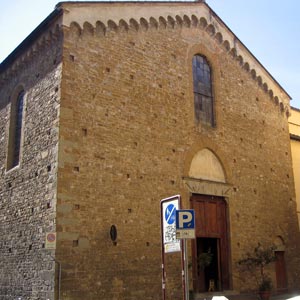 Cross the street and arrive in Via de’ Neri, turn right in the second street and you are in a little square with a church: the name of both is San Remigio.
Cross the street and arrive in Via de’ Neri, turn right in the second street and you are in a little square with a church: the name of both is San Remigio.
Built in the 11th century, and rebuilt in the years between 1200 and 1300, as home for French pilgrims. Experts say that the planners of Santa Maria Novella drew inspiration from this church.
I think this is time for a good ice-cream: Vivoli, the most famous ice cream shop in Florence is in Via Isola delle Stiche 7. This street is just back a street named Via Torta (crooked street). This is really a crooked street as in the past here there was a Roman Theatre.
Go back to Via de’ Benci through via de’ Rustici and have a look in Piazza Peruzzi and its beautiful palaces.
From Via de’ Benci proceed in Via Verdi (on the corner you’ll see the Verdi Theatre and arrive in Via Pietrapiana, turn right (Piazza Salvemini) On the corner in front of you there is an ancient Pharmacy, the chemists are not very friendly because there are working there as in all the other pharmacies, but you can buy plasters or vitamins just to be allowed to have a look inside. The name of the Pharmacy is “Canto alle Rondini” which means “Swallows corner”.
On the left you enter in Borgo la Croce.
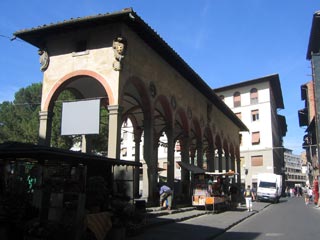 This part of Florence is very busy, along the street you find Piazza dei Ciompi, with a flea market (also the last Sunday of each month) and an arcade named “Loggia del Pesce” (Fish market) which was one of the Loggia used as food market in the old Florence together with the “Loggia del Mercato Nuovo”also called “Loggia del Porcellino” (near Por Santa Maria), Loggia del Grano – 1619 (grain Market).
This part of Florence is very busy, along the street you find Piazza dei Ciompi, with a flea market (also the last Sunday of each month) and an arcade named “Loggia del Pesce” (Fish market) which was one of the Loggia used as food market in the old Florence together with the “Loggia del Mercato Nuovo”also called “Loggia del Porcellino” (near Por Santa Maria), Loggia del Grano – 1619 (grain Market).
Go on and arrive in front of the old church Sant’Ambrogio and its nice bell tower.Visit the church if you like and have time and then turn in Via de’ Macci. Here you find one of the most famous restaurants of Florence, the Cibreo, where you can taste Florentine food. The Restaurant is not very cheap, and if you like to go there, reserve your dinner.
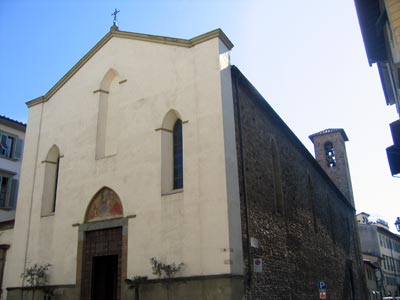 Near it the little Cibreo allows you to taste some good and inexpensive food. In the same street you can taste a very good pizza at Il Pizzaiolo, but if you are here at about lunch time, go into the very popular food market: Sant’Ambrogio. Inside the food market there is a little Trattoria. “Rocco” where you can have a good Florentine lunch or even only a fresh salad. This Trattoria is opened only till 2pm because it is mainly for the market workers. If you are in the mood of tasting particular things, in Via de’ Macci you can find a kiosk where you can eat a “panino col lampredotto”, roll filled with a kind of tripe (excellent!).
Near it the little Cibreo allows you to taste some good and inexpensive food. In the same street you can taste a very good pizza at Il Pizzaiolo, but if you are here at about lunch time, go into the very popular food market: Sant’Ambrogio. Inside the food market there is a little Trattoria. “Rocco” where you can have a good Florentine lunch or even only a fresh salad. This Trattoria is opened only till 2pm because it is mainly for the market workers. If you are in the mood of tasting particular things, in Via de’ Macci you can find a kiosk where you can eat a “panino col lampredotto”, roll filled with a kind of tripe (excellent!).
Walking along via de’ Macci you have to turn right inVia Ghibellina, where on the right you can see Casa Buonarroti (Michelangelo house)
This house was built on the place of three houses Michelangelo had bought in 1516/1525, by Michelangelo grandnephew. Turn right in one of the streets you find (Via de’ Pepi or Via Verdi Or Via M. Palmieri) and reach Borgo degli Albizi, here turn left and go on admiring the beautiful palaces of this street such as Albizi Palace, Alessandri Palace, Altoviti Palace. At the end of this street you are again in Via del Proconsolo where you started your tour.
Back to tours list
Tour 6 Quarter: Oltrarno (The other side of the river Arno)
Since 1343 this part of Florence has been the district of Santo Spirito which, together with Santa Croce, was the area for industry and handicraft. Still now you can see many workshops of restorers and artisans.
We have to divide this tour into two parts: the first from Ponte Vecchio to Pitti Palace and the second includes Santo Spirito and San Frediano.
From Ponte Vecchio we continue under the arch of Vasari Corridor and soon we are in Piazza Santa Felìcita, this church was built in Romanic period on an old early Christian basilica (IV century) and together with San Lorenzo is one of the most ancient churches. (description in “Churches” section).
We go on into Via Guicciardini, here among modern palaces, there is the Franceschi Palace (nr 11 – 13) and the Guicciardini-Benizzi Palace, you can only see the entrance with a gate and a fountain. This palace is at the corner with Piazza Pitti. And the large sloping down square, makes Florence (together with Venice) one of the most “theatrical” towns in Italy.
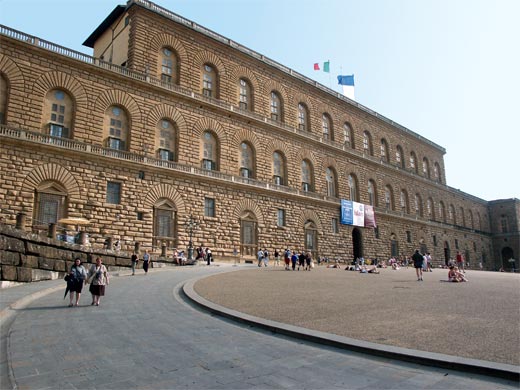
The palace is the biggest in Florence (205 mt long) and one of the most famous, inside the left part, you can visit the “Galleria Palatina” where are the collections of art works of the Medici Family and masterpieces by Raffaello, Tiziano and many others important Italian and European artists. (Description in the section “Museums”) In the palace there are also the “Appartamenti reali”, “The modern art Gallery” and the “Argenti Museum”
You cannot miss a visit to Boboli Gardens (description in the section: “Gardens”) which is one of the most famous and splendid gardens in Italian style.
The second part of the tour starts from Santa Trìnita Bridge and proceed in Via Maggio (ex Via Maggiore – Major Road) This was the route of the public processions and is one of the streets of Florence with a great number of aristocratic palaces, each palace has a tablet with the name and a short description. The most important of these palace is the Bianca Cappello palace (1570/74) by Bernardo Buontalenti.
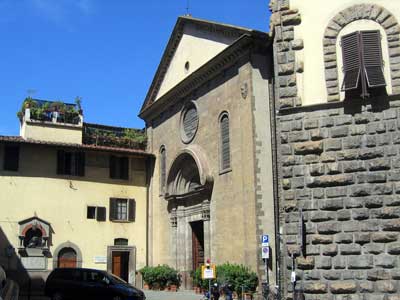 At the end of Via Maggio there is the little square with a marble columns which has the same name of the church: San Felice in Piazza, this church is named in documents of 1066 but it was rebuilt in 14th century and modified in 16th and 17th centuries. The Renaissance façade was made by Michelozzo (1452/60). Coming out of the church on the right walk along Via Romana, this was the road from Ponte Vecchio to Rome, this is not so elegant as Via Maggio, but in its first part you can see the ancient Torrigiani Palace (at nr 17), also named “La Specola” (the observatory) because the Duke Pietro Leopoldo installed an astronomical and metheo observatory. There, to day it is the seat of the Specola zoological Museum. Here you can visit important and precious wax anatomic models of the 18th century.
At the end of Via Maggio there is the little square with a marble columns which has the same name of the church: San Felice in Piazza, this church is named in documents of 1066 but it was rebuilt in 14th century and modified in 16th and 17th centuries. The Renaissance façade was made by Michelozzo (1452/60). Coming out of the church on the right walk along Via Romana, this was the road from Ponte Vecchio to Rome, this is not so elegant as Via Maggio, but in its first part you can see the ancient Torrigiani Palace (at nr 17), also named “La Specola” (the observatory) because the Duke Pietro Leopoldo installed an astronomical and metheo observatory. There, to day it is the seat of the Specola zoological Museum. Here you can visit important and precious wax anatomic models of the 18th century.
Going back to Piazza San Felice, turn left into Via Mazzetta and in a short time you are in Piazza Santo Spirito. In the centre there is the monument to Cosimo Ridolfi and at nr 10 the big beautiful Guadagni Palace.
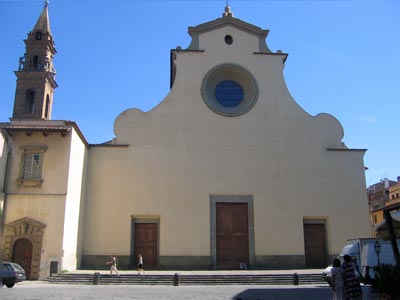 Looking at the simple façade of the church you cannot imagine that in the back of it you are going to see, is one of the best architectonic building of the Renaissance. And when we speak of the genius of the Renaissance we mean Brunelleschi.
Looking at the simple façade of the church you cannot imagine that in the back of it you are going to see, is one of the best architectonic building of the Renaissance. And when we speak of the genius of the Renaissance we mean Brunelleschi.
We leave the square in the direction of via Mezzetta, which now is Via S.Agostino to the crossing with Via de’ Serragli. Also in this street there are palaces which date back to 1400/1550, the Ferroni Palace (nr.8 – 1450) and Antinori di Brindisi Palace (nr.7/9) are very interesting. You can go on along this way and have a look at some tabernacles one on the corner Via de’ Serragli/Via della Chiesa , there is a fresco by Cesare Ulivelli, near Via del Campuccio and a Crucifixion by Giovanni di San Giovanni, and then go back to the crossing Via de’ Serragli and Via Santa Monaca, on the corner the façade of Mazzei Palace includes one more tabernacle by Bicci di Lorenzo. At nr 6 there is the Church of Santa Monaca.
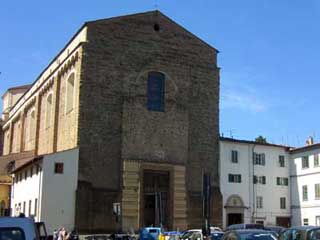 In a short time you are in Piazza del Carmine whit the church of Santa Maria del Carmine. The description of this church is in “Churches” section. It is famous for the frescoes by Masaccio and Masolino in Brancacci Chapel (do not miss them!) – the description of the chapel is inside the church description.
In a short time you are in Piazza del Carmine whit the church of Santa Maria del Carmine. The description of this church is in “Churches” section. It is famous for the frescoes by Masaccio and Masolino in Brancacci Chapel (do not miss them!) – the description of the chapel is inside the church description.
Tour 7 Quarter: Piazzale Michelangelo
Piazzale Michelangelo offers one of the most famous view of Florence. You have several ways to go there: by bus (nr 13 or nr 12), walking from Piazza Poggi (left side of the Arno). This is a nice walk in a uphill road which crosses a fashinating green area. As it is a famous place, it is always overcrowded with tourists. If you visit Florence in April/May you can also visit the rose garden (free entrance, the entrance is on the right before arriving in Piazzale Michelangelo) quiet and very beautiful. To avoid the crowd, buy a drink in one of the bars of Piazzale Michelangelo and go and have it on a bench in the rose Garden in front of an amazing panorama among roses of every colour and kind. In this period you can also visit the Iris Garden, on the opposite side of the Rose Garden, here the entrance is not free, but you can admire many iris of incredible colours. There are several bars here: all of them are a little expensive, so if you like to seat in front of one of the most famous panorama of the town, you can seat in La Loggia- Caffè which is the best one (and quiteprobably the most expensive).
Peculiarity: If you visit Piazzale Michelangelo on Sunday morning, you cannot help noticing many Chinese wedding. They often arrive with a limousine (do not ask me where they can find a limousine in Florence, because I have never seen one of these cars in my town in all my life), the bride usually wears a white long dress with train, and uncomfortable shoes with a very tall sole. Friends and relatives throw paper coloured confetti instead of the rice we are used to throwing on the couple coming out of the church, as a good luck wish. These are not real wedding, because very often thesse people, who live in the neighbourhood of Florence and work hard almost without any contact with local people, marry by proxy and this is not a real wedding ceremony but a feast in western style.
Behind the Loggia-Caffè, long stairs climbs up a hill named “Monte alle Croci” and leades to the church of San Salvatore al Monte (1499) Inside the church there are chapels which remind SS. Anunziata. To go and visit San Miniato (one of the best and most fascinating churches of Florence) I suggest to go on in this direction so that you can see what remains of the fortification by Michelangelo. On the top of the hill, there is San Miniato which, together with the Baptistery, is the most important Romanic building in Florence. (Description in “churches” section).On one side of the church there is the Vescovi Palace (1295/1320) which is part of a monastery. On the left side there is the monumental Cemetery where many important Florentines are buried.
The route goes on into Viale Galilei to get, along Via San Leonardo to Forte Belvedere. Via San Leonardo is a nice typical Tuscan road with high walls hiding villas under olive trees and cypresses. On the left there is the church of San Leonardo in Arcetri. Walk as far as you arrive in front of St. George Gate, on the left you have the Forte Belvedere. A visit to this fortress, built in 1590, is recommended.
Out of the fortress you can go downtown passing under the San Giorgio Gate, in Costa a San Giorgio, a steep old and fascinating narrow street with foreshortened views. In a short time you are near Ponte Vecchio.

You must be registered to post comments.